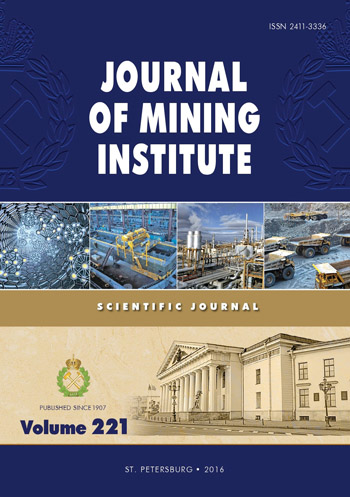А analysis and classification of resource saving technologies for reproduction of mineral resources оf titanium industry
- 1 — Ph.D., Dr.Sci. professor Saint-Petersburg Mining University
- 2 — Ph.D., Dr.Sci. Doctor of Commerce, Professor University of Modena and Reggio Emilia
- 3 — post-graduate student Saint-Petersburg Mining University
Abstract
At present self-sufficiency in mineral feedstock of the Russian economy has dropped significantly, with some types of mineral feedstock becoming extremely scarce after the collapse of the USSR. Analysis of mineral resource base of the companies of titanium-magnesium, chemical, paint and varnish and other sectors of industry, producing titanium products, has shown that these sectors have almost no titanium feed- stock of their own production, even with account of titanium low consumption. The use of resource saving technologies instigates creation of new forward-looking methods for reproducing mineral resource base of the titanium industry by bringing new, unconventional types of extractable resources into the economic turnover and is one of main ways to increase the natural resource potential of the industry. A rational combination of modern highly productive machinery and resource saving technologies is the only possible way for the development of a number of valuable extractable resources, including titanium dioxide. The paper gives an overview of key aspects of the modern resource saving technologies for expansion of reproduction in the basic industries. An idea is put forward to recreate the titanium industry resource base in the Russian Federation based on the modern resource saving technologies. A classification of the modern resource saving technologies is proposed.
References
- Vodop'janov A.G. The development of the process of obtaining a concentrate of titanium dioxide for welding electrodes. Tehno-logicheskie i jekologicheskie problemy otrabotki prirodnyh i tehnogennyh mestorozhdenij: Sb. dokladov nauchn.-praktich. konferencii (1-2 oktjabrja 2013). IGD UrO RAN. Ekaterinburg, 2013, p.23-27 [in Russian].
- Akimova A.V., Berezner O.S., Dorozhkina L.A. et al. State report on the status and use of mineral resources of the Russian Federation in 2013. Moscow, 2014. Available at: URL: www.mnr.gov.ru/upload/iblock/914/Report2014.pdf (date of access 20.05.2016).
- Kozlov A.V., Fedoseev S.V., Cherepovicyn A.E. et al. Integrated development of economic space of the Arctic zone of the Russian Federation. St. Petersburg: Izd-vo Politehn. un-ta, 2016, p.315 [in Russian].
- Fedoseev S.V., Tochilo M.V. Analysis of the production and consumption of titanium dioxide in Russia and abroad. Sever i rynok: formirovanie jekonomicheskogo porjadka. Apatity, 2015. N 4 (47), p.121-128 [in Russian].
- Porter R. Mineral sands industry. Australia, Narngulu, 2014. Available at: URL: www.iluka.com/docs/default-source/industry-company-information/the-mineral-sands-industry-factbook-(feb-2014) (date of access 15.05.2016).
- Tiwari R. Titanium dioxide industry trends and 2017-2019. Forecasts for Global and China Regions // SOURCE RnR Mar- ket Research. USA, Dallas, 2014. N (27). Available at: URL: www.prnewswire.com/news-releases/titanium-dioxide-industry-trends-and-2017---2019-forecasts-for-global-and-china-regions-284067121.html (date of access 10.05.2016).
- Hayes Т. Titanium dioxide a shining future ahead // Industrial Metals. Canada, 2011. Available at: URL: www.argex.ca/documents/Euro_Pacific_Canada_Titanium_Dioxide_August2011%5B1%5D.pdf (date of access 13.06.2016).
- Gázquez M.J. A Review of the production cycle of titanium dioxide pigment / M.J.Gázquez, J.P.Bolíva // Materials Sciences and Applications. 2014. N 5. P.441-458 Available at: URL: www.file.scirp.org/pdf/MSA_2014052916520642.pdf (date of access 20.05.2016).
- Physicochemical characterization of raw materials and coрroducts from the titanium dioxide industry / M.J.Gázquez, J.P.Bolívar, R.Garcia-Tenorio, F.Vaca // Journal of Hazardous Materials. 2009. N 166. P.1429-1440. Available at: URL: www.dx.doi.org/10.1016/j.jhazmat.2008.12.067 (date of access13.06.2016).
- Middlemas S. A new method for production of titanium dioxide pigment / S.Middlemas, Z.Z.Fang // Hydrometallurgy. 2013. N 131. P.107-113. Available at: URL: www.elsevier.com/locate/hydromet (date of access 10.06.2016).
- Barlow E. A Review of global supply and demand for titanium dioxide // PCI Magazine. N 6. 2015. P.120-124. Available at: URL: www.pcimag.com/articles/100036-a-review-of-global-supply-and-demand-for-titanium-dioxide (date of access 25.05.2016).
- Sahu K.K. An overview on the production of pigment grade titanium from titanium-rich slag / K.K.Sahu, T.C.Alex, D.Mishra // Waste Management & Research. 2006. N 24. P.74-79. Available at: URL: www.wmr.sagepub.com/content/24/1/74.full.pdf+html (date of access 10.05.2016).
